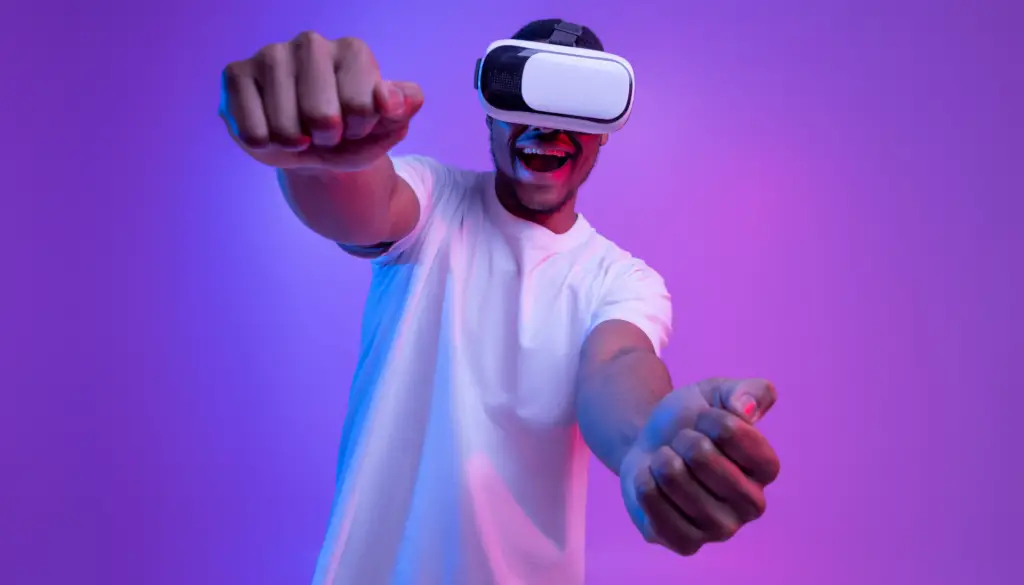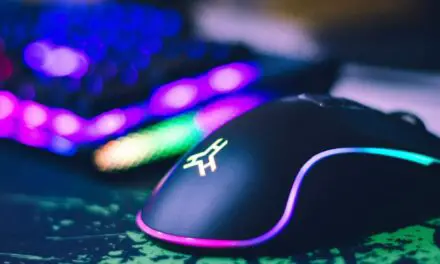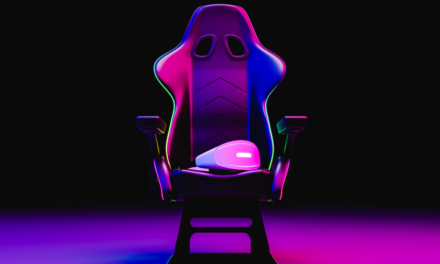In a society often quick to label gaming as a sedentary pastime, the notion that you could burn enough calories to lose weight while gaming is often dismissed.
So if you’ve ever wondered whether beating that final boss is akin to reaching your daily step count, you’re in the right place.
In this article, we’ll explore scientific studies and real-world examples to answer the question: Can Gaming Burn Calories?
Table of Contents
Can Gaming Burn Calories?

Absolutely, gaming can burn a low to moderate amount of calories, but don’t swap your gym membership just yet! While the caloric burn from gaming is relatively low—usually around 100-200 calories per hour for a vigorous session—it’s not insignificant. Factors like emotional intensity and using motion-controlled peripherals can amp up the burn. However, it’s a good deal less than traditional exercise methods. You could think of gaming as a light supplement to a more rigorous weight loss plan.
The Science of Burning Calories and Why Gaming Doesn’t Burn So Many
To get a better understanding of how gaming stacks up as a calorie-burning activity, let’s stick our lab coats on for a minute and touch on the science of weight loss. Weight loss fundamentally boils down to a simple equation: calories in versus calories out. You need to expend more calories than you consume to shed those pounds. Activities like running, swimming, and high-intensity interval training (HIIT) can torch anywhere from 500 to 1,000 calories per hour, thanks to their impact on large muscle groups and cardiovascular demand.
Why doesn’t gaming stack up to these calorie-burning champions? The reason is primarily physiological. Most video gaming is a sedentary activity, lacking the full-body movements or cardio stress that make exercises like running a calorie furnace. You’re primarily using your fingers and perhaps wrists, which involve smaller muscle groups and hence fewer calories are burned. Additionally, the emotional highs and lows might rev up your heart rate momentarily, but they don’t sustain the kind of metabolic spike needed for significant calorie burning.
But what about motion-controlled games, you ask? True, swinging a virtual tennis racket or dancing to a rhythm game will elevate your calorie burn, but even these activities usually don’t approach the burn rates of traditional aerobic exercise.
Gaming usually offers a light calorie burn but just like with any exercise, the more you move, the more calories you will burn. If you’re playing Just Dance and absolutely going for it for an hour straight, you’re going to get a good workout in and you’ll be needing a shower afterwards. Whereas playing Tekken for an hour would probably only make your controller sweaty.
How Many Calories Can You Actually Burn When Gaming?
Knowing how many calories you’re burning—or not burning—is important if you want to view your gaming sessions in the context of weight loss.
Breakdown by Type of Gaming
Not all game types are equal when it comes to shedding pounds. Let’s look at which ones offer the best bang for your buck.
Casual Gaming
You’re lounging on the couch, swiping at candies or solving puzzles on your mobile device. Casual gaming, which often involves less intense focus and simpler controls, burns the least amount of calories among gaming types. Think around 50-80 calories per hour, depending on factors like the temperature of your environment, your body weight and age. It’s the equivalent of light stretching or sitting and chatting.
Competitive Gaming
Esports athletes or anyone locked into a high-stakes, high-intensity online battle: Your calorie burn ramps up, but not by a huge amount. The heightened stress and rapid hand-eye coordination might increase your hourly caloric burn to around 100-150 calories. It’s comparable to standing or light house chores.
VR Gaming
Step into the virtual reality world, and things get a bit sweatier. VR gaming often involves full-body movements, ducking, dodging, and even lunging. You’re looking at an expenditure of around 200-300 calories per hour, roughly equivalent to a slow-paced walk.
Active Gaming
Think Wii Sports or Just Dance—games explicitly designed to get you moving. These can offer a moderate calorie burn of approximately 300-500 calories per hour, akin to a brisk walk or light jogging. You’re getting pretty close to gym-worthy here, depending on how hard you push it.
To put it into perspective, here’s how gaming stacks up against other everyday activities:
- Walking: 300-400 calories per hour
- Doing Chores: 150-200 calories per hour
- Sitting and Watching TV: 40-70 calories per hour
- Sleeping: Approximately 50-60 calories per hour
Most gaming scenarios barely touch the lower end of what traditional exercises can burn. However, they are a lot better than being entirely sedentary. So if you’re on a weight loss journey, gaming can fit into your overall caloric budget.
But don’t forget to consider your diet too! Which can often provide far better bang for your buck when trying to lose weight.
Consider this: a standard 2-ounce bag of salted potato chips has around 310 calories. To put that in perspective, you’d need to walk for about an hour or run for about 30 minutes to burn that off.
What Does the Science Say on How Many Calories Gaming Burns?
Let’s dive into the numbers and see what science has to say about gaming and calorie burn. We’ve looked at a couple of recent studies that look closely at how gaming impacts calorie burning.
The Betway Insider Study on Gaming and Weight Loss
Let’s dive into some key findings, dissect them, and extract what they mean for gamers eyeing weight loss.
Can You Skip the Gym for Gaming?
The study says you can burn a maximum of 538 calories per 90-minute gaming session on average. While that’s a considerable amount, remember that traditional workouts often surpass this, especially activities like running or swimming.
Which Play on the Couch Games Burn the Most Calories
Fortnite tops the list, burning 194 calories in 90 minutes, followed closely by Fifa (189) and Call of Duty (188). Grand Theft Auto V still allows you to burn a respectable 164 calories. What this suggests is that high-intensity, competitive games might offer more calorie-burning potential than slower-paced narratives or sandbox games.
Heart Rate Impacts Calorie Burn
More competitive games like Fortnite and Call of Duty: Warzone pushes players’ heart rates to peak levels, hitting an average maximum of 119 BPM. The heart rate data is noteworthy, as increased heart rate often correlates with higher energy expenditure.
The Exercise Equivalent
Here is an interesting stat from the study: You’d need to do 353 squats to match the calories burned in a 90-minute Fortnite session.
The study is at least a starting point for understanding how gaming could fit into a weight loss regimen. But don’t cancel your gym membership yet. It might be better to use these insights as a way to supplement your existing fitness plan rather than replace it. Gaming can form a small but enjoyable part of your weight-loss journey—it’s more like a side quest to your main mission of hitting those fitness goals.
Related Article: 12 Reasons Why OLEDs Are Great For Gaming
The Stakester Study on Gaming and Calorie Burn
Conducted by esports platform Stakester, this study proposes that gaming might be more of a calorie burner than we’ve previously given it credit for.
The Caloric Equivalent of 1000 Sit-ups
According to the study, male gamers can torch a remarkable 420 calories over a two-hour session, equivalent to doing 1000 sit-ups. I don’t know about you but I think I’d be going with the gaming, considering that I don’t think I could do 200 sit-ups in that time. And that’s the same as burning 210 calories per hour, rivaling some low to moderate traditional workouts.
Stakester’s CEO Tom Fairey aptly mentioned the “gaming sweat” phenomenon, illustrating that when the stakes are high, so is the caloric burn. This research tracked heart rates and calorie burns across FIFA and Warzone sessions, emphasizing the role of competitive intensity in burning calories.
Gaming and Health: A Complex Relationship
While these numbers are intriguing, they come from a platform that, let’s face it, has a vested interest in promoting the benefits of gaming. That said, a previous study by Queensland University of Technology (QUT) does support the idea that gamers might be healthier than we think. According to the QUT study, gamers are 21% more likely to have healthier body weights, smoke and drink less, and are more active than the general population.
What Does This Mean for You?
As fascinating as these studies are, it’s essential to approach them with a dose of realism. Yes, gaming can contribute to a calorie deficit, but it shouldn’t replace a balanced fitness regimen and if you snack on junk food while you game you’ll never burn more calories than you consume.
If anything, these findings should motivate you to embrace gaming as a part of a holistic approach to health, not the cornerstone.
Tips for a Healthier Gaming Lifestyle
Let’s consider how we can incorporate gaming into a healthier lifestyle.
Making Time for Physical Exercise
Don’t let your virtual 10,000-step quest replace the real deal. Schedule in 30 minutes to an hour of aerobic exercise most days of the week. Be it a run around the block or a quick YouTube-led HIIT workout, the benefits for your body—and gaming stamina—will be undeniable.
Healthy Gaming Snacks
Switch the Doritos for carrot sticks, and put that soda back in the fridge. Opt for healthy snacks that are high in protein and low in sugar to maintain your energy levels during gaming marathons. Think along the lines of homemade popcorn, Greek yogurt, or fresh fruit.
Setting Time Limits
Set a timer or use built-in parental controls to manage your gaming hours. Excessive screen time can lead to eyestrain, sleep issues, and, frankly, fewer calories burned. Limit sessions to reasonable chunks, say, 90 minutes to 2 hours, then step outside for some fresh air and real-world activity.
Ergonomics for Better Health
Don’t underestimate the power of a good chair and desk setup. Your back will thank you. Ergonomic gaming chairs with lumbar support, adjustable armrests, and tilting functions are game-changers. You won’t want your back to be in bits when it comes time to jump up and get active.
Your screen should also be at eye level, and your table should allow for a neutral wrist position. Small adjustments like these significantly mitigate long-term health risks tied to bad posture or sedentary behavior.
Gaming doesn’t have to be a bane to your health. With the right strategies in place, you can quest your way through fantastical worlds while keeping your real-life health meters in check. And let’s be honest, healthier gamers are better gamers.



